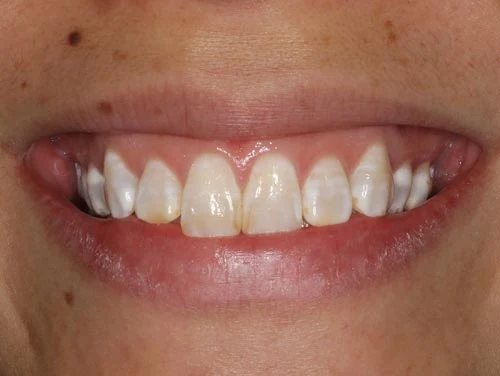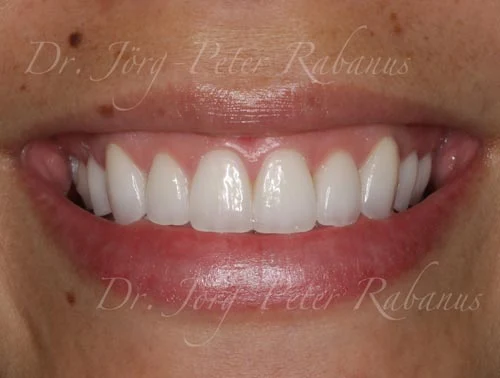What are the best porcelain veneers?
The simple answer is that porcelain veneers are at their best when they don't look like veneers,
and the patient loves his/her new smile.


How do we get there?


How do we get there?
There is no simple answer for this question. But there is an essential smile makeover treatment sequence that is applied by the leading cosmetic dentists worldwide to give their patients the smiles that they are looking for.
It takes a systematic approach to create a smile that is LOVED by the patient.
6. Compare and cross-reference patient's goals with diagnostic findings.
7. Establish a thorough understanding of the treatment options that cosmetic dentistry can provide.
8. Once a goal has been agreed to, outline the route in detail to establish realistic expectations.
9. Execute at the most expert level.
10. Maintain two-way communication at every step to assure that the patient understands each step at an understandable gradient.
11. Deliver with highest scientific understanding and application of all dental materials involved.
12. Ensure that all goals have been attained and patient LOVES his/her new smile.


Glossary of Terms:
Porcelain Veneers are thin wafers of porcelain that are laid on tooth surfaces to improve their shape, color, and texture. Groups of porcelain veneers, when applied by a skilled cosmetic dentist, lead to new smiles that are more youthful, healthy, and attractive.
Masticatory System is a set of body structures that contribute to chewing function, including jaws and jaw muscles, teeth, temporomandibular joints, tongue, lips, cheeks, and mucous membranes.
Buccal Corridor is defined as the space between the outside surfaces of the maxillary first premolars and the inner meeting point of upper and lower lips join at each respective side during a smile. It has been described as a ratio by dividing the distance between the inner lip commissures by the distance between the first maxillary premolars.
Periodontal Health is defined as the absence of any disease or impairment of the periodontal tissues as observed by the cosmetic dentist. As part of the masticatory system, it contributes to adequately meeting all demands of oral function. It implies the absence of disease and impairment. Evidently, this does not just mean that a patient "feels" fine. Many conditions that indicate a deterioration of periodontal health can only be determined by your dentist. Regular visits in six-month intervals are considered a preventive means to discover these conditions early so that advanced periodontal disease can be prevented. (See also The Meanings of Health and its Promotion.)
Diagnostic Findings is a term that applies to medical diagnosis, which consists of a description of signs and symptoms. While te term "signs" indicates changes of biological tissues that are observed by the specialist, such as redness, induration, and clinical measurements, the term "symptoms" contains all the things that are experienced by the patient, such as weakness, pain, discomfort, etc. The word "diagnostic findings" indicates the signs that have been discovered by an examining medical professional, then being required to communicate his/her findings to the patient, so that proper action can be taken to prevent a worsening of the condition or its complete elimination.
Cosmetic Dentistry is the science and practice of dentistry that is aimed at creating a positive change to your teeth and to your smile. (See also AACD.)
Realistic Expectations are established by communication between two parties, often one service provider and one recipient of services. The recipient gets educated to develop a good grip on the reality of his/her situation and understanding what can and cannot be done. This includes practicality and affordability. A patient's expectation becomes realistic when his/her perception of the likelihood or probability of outcomes for each option are well known and when they help the patient to define the probablities of outcomes. Hence, the execution of an "educate choice" becomes possible.
Porcelain veneers in San Francisco Change Lives.
References:
Erics RE et al. A predictable approach for enhanced aesthetics: A case report. Pract Proced Aesthetic Dentistry, 2010 vol. 9 (2); 229-231.
Sarver DM et al. Dynamic smile visualization and quantification: Part 1. Evolution of the concept and dynamic records for smile capture. Am J Orthod Dentofacial Orthop, 2003 vol. 124 (1); 4-12.
Haupt J et al. Subtle Embrasures and a youthful smile. American Academy of Cosmetic Dentistry, 1997 vol Fall; 58-62.
Sterrett JD et al. Width/length ratios of normal clinical crowns of the maxillary anterior dentition in man. J Clin Periodont, 1999 vol. 26 (3); 153-157.
Isiksal E et al. Smile esthetics: Perception and comparison of treated and untreated smiles. Am J Orthod Dentofacial Orthop, 2006 vol. 129 (1); 8-16.
Wells DJ. The Lateral Incisor: The Unsung Hero in Smile Design. American Academy of Cosmetic Dentistry Journal, 1999 vol. Fall; 38-46.
Mahshid M et al. Evaluation of "golden proportion" in individuals with an esthetic smile. J Esthetic Restorative Dentistry, 2004 vol. 16 (3); 185-192.
Morley J. Smile Design Terminology. Dentistry Today, 1996 vol. May/June; 70-71.
Chu SJ. A biometric approach to predictable treatment of clinical crown discrepancies. Pract Proced Aesthetic Dentistry, 2007 vol. 19 (7); 401-409.
Ker AJ et al. Esthetics and smile characteristics from the layperson's perspective A computer-based survey study. J AM Dental Assoc, 2008 vol. 139 (10); 1318-1327.
Miller CJ. Esthetic Dentistry - The Smile Line as a Guide to Anterior Esthetics. Dental Clinic North Am, 1999 vol. 33 (2); 157-164.
Ritter DE et al. Esthetic influence of negative space in the buccal corridor during smiling. Angle Orthod, 2006 vol. 76 (2); 198-203.
Sesemann MR. The diagnostic tracing analysis--visualization by the numbers. Pract Proced Aesthetic Dentistry, 2004 vol.16 (8); 567-572.
Beall AE. Can a New Smile Make You Look More Intelligent and Successful? Dental Clinic North Am, 2007 vol. 51 (2); 289-297.
Methot A. "M" Proportions - The New Golden Rules in Dentistry. Spectrum – AACD Issue, 2006; 1-6.
Vallittu PK et al. Dental aesthetics--a survey of attitudes in different groups of patients. J Dentistry, 1996 vol. 24 (5); 335-338.
Wolfart S et al. Subjective and objective perception of upper incisors. J Oral Rehabil, 2006 vol. 33 (7); 489-495.
Parekh SM et el. Attractiveness of variations in the smile arc and buccal corridor space as judged by orthodontists and laymen. Angle Ortho, 2006 vol. 76 (4); 557-563.
Sesemann MR. Utilizing diagnostic tracing analysis for smile design. AACD Monograph, 2010; 1-4.
Sarver DM et al. Dynamic smile visualization and quantification: Part 2. Smile analysis and treatment strategies. Am J Orthod Dentofacial Orthop, 2003 vol. 124 (2); 116-127.
Ong E et al. Peer assessment of dental attractiveness. Am J Orthod Dentofacial Orthop, 2006 vol 130 (2); 163-169.
LeSage BP et al. Approaches to Smile Design - Mathematical to Artistic Interpretation. J Cosmetic Dentistry, 2012 vol. 28 (1); 126-147.
Weinstein SP. Classification of clinical attributes in tooth appearance. Pract Proced Aesthetic Dentistry, 2008 vol. 20 (3); 143-151.
Tsuzuki Y. Creating vivid life into our creations. Combining artistic sensibility with functional essentials achieves the desired outcome. J Cosmetic Dentistry, 2016 vol. 32 (3); 26-40.
Zeller S et el. Using Digital Smile Design to Yield Predictable Results. Inside Dentistry, 2018, vol. February; 32-38.
Jardim da Motta AF et al. Display of the incisors as functions of age and gender. Austral Orthod J, 2010 vol. 26 (1); 27-32.
Rafael CF et al. Affectina Anterior Esthetics in W All-Ceramic Restorations - Two Case Reports. J Cosmetic Dentistry, 2007 vol. 33 (3); 56-64.
Sesemann MR. Appropriate Line Angles to Optimize Smile Design Restorations. J Cosmetic Dentistry, 2007 vol. 33 (3); 66-75.
Canizares R. Creating a Beautiful Smile with Conservative Porcelain Veneers. J Cosmetic Dentistry, 2007 vol. 33 (3); 18-22.
Sisler ZS. Esthetic Dentistry Built with Sound Functional Principles. Inside Dentistry, 2017 vol. March; 57-62.



